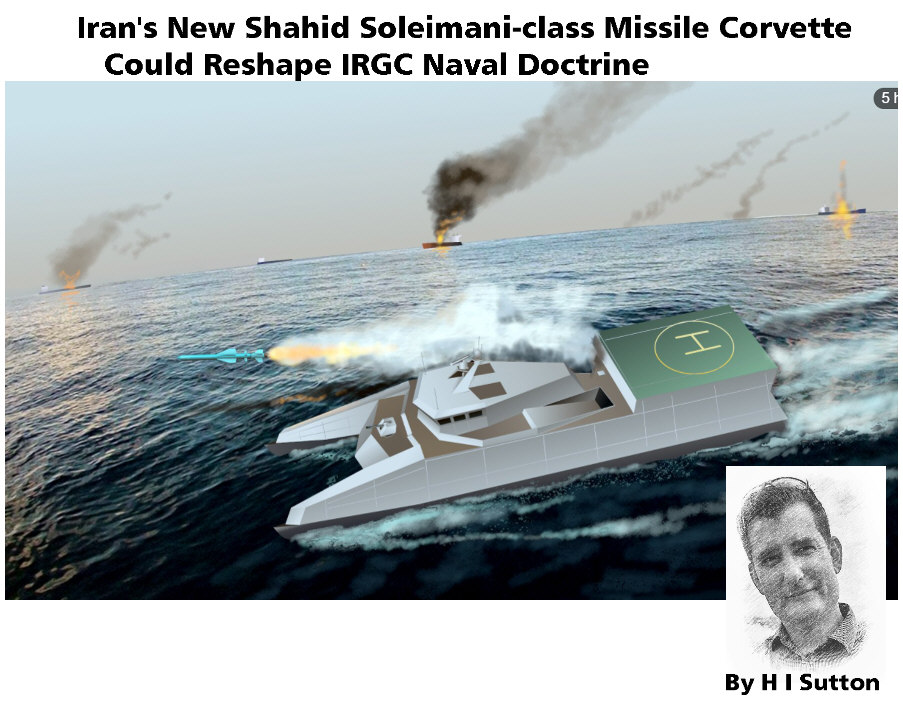
According to satellite imagery, at least three of the new type are under construction simultaneously. One is being built at the Shahid Mahallati Shipyard in Bushehr. Another is in a small boatyard near Bandar Abbas. A third is under construction at a new shipyard near Shib Deraz – on the island of Qushm – that may also be involved in submarine construction, according to analysts.
Iran’s Islamic Revolutionary Guard Corps Navy (IRGC-N) is building a new class of warships, as first reported in Naval News last week based on satellite imagery. The catamaran design appears relatively large, modern and capable compared to existing IRGC commercial-based designs.
The sectarian arm of the Iranian military’s move to more substantial warships may be part of a wider effort by the IRGC-N to gain conventional naval capabilities more in line with the regular IRIN (Islamic Republic of Iran Navy).
Addition Notes
Iran’s naval doctrine relies on a layered defense and massing of firepower, integrating multiple sea, land and air-based weapons simultaneously to overwhelm and confuse adversaries. As Iran’s naval doctrine has matured, the Iranians have acquired a large inventory of naval materiel suitable for asymmetric warfare. This includes naval mines, which can be covertly deployed using small boats or commercial vessels; land and sea-based anti-ship cruise missiles; small fast-attack craft, which can engage in swarming operations or suicide attacks; and submarines, including three Russian-supplied KILO-class diesel-electric submarines and numerous North Korean and domestically produced midget submarines, which can be used in the Gulf’s shallow areas.
The IRGCN’s doctrine reflects irregular warfare principles that include the use of, surprise, deception, speed, flexibility and adaptability, decentralization, and highly mobile and maneuverable units. All of these on the sea. These warfare methods include hit-and-run style, surprise attacks, or the amassing of large numbers of means and measures to overwhelm the enemies’ defenses. In this event, the employed naval forces could described as a swarm of small boats using their size and maneuverability to track and hunt down enemy warships.
The IRGCN’s mosquito-fleet concept enables rapid formation of tactical groups of small crafts to carry out a surprise strike from different directions in a particular area in the offshore zone and at a particular time. Such groups can deploy in attack formation immediately prior to reaching the area of the attack.
Crafts from the formation reach their assault position line independently or by small groups. Therefore, the Iranian naval thought intends to employ the swarm concept. It’s important to note the high motivation and ideological training of mariners involved. Personnel understand perfectly well the high level of threat to them personally in the event of the employment of this tactical scheme. IRGCN personnel are motivated and ready to accomplish a feat to defend their homeland. This factor (the high motivation of the personnel) makes a mosquito-fleet armed with missile, torpedo and anti-air weapons especially dangerous to naval forces of Western states.
The IRGCN employs several types of boats:
Fast Attack Craft (FAC) – it has 10 Chinese-built Houdong WPTGs, acquired in the mid-90s. These are the capital ships of the IRGCN, they used to be equipped with C802 missiles, but were upgraded with Ghader missiles.
Immediately, after acquiring the Houdongs, the IRGCN shifted its focus on even smaller boats. In a 10-year period between ’96 and ’06, it acquired 46 FACs from China and North Korea, they are equipped with torpedoes, short-range anti-ship cruise missiles, or both, and can reach speeds of 40-50 knots;
Fast Inshore Attack Craft – these are lightly armed boats which the IRGCN has been successfully using since the 1980s, and are one of the largest threats it presents.
The IRGCN has a copy of the British-built Bladerunner – the Siraj-1. The Siraj-1 is armed with multiple-rocket-launcher system and a heavy anti-aircraft machinegun on the prow. It can reportedly reach a speed between 55 to 72 knots. Another boat is the Zolfaghar, which reaches a maximum speed of 70 knots and mounts an integrated radar and two launch canisters for Nasr-1 cruise missiles on its stern.
The IRGCN further has semi-submersible boats, that can partially submerge below the water surface to evade detection and can be used for sabotage, special-forces insertion and spying. IRGCN patrols in the Strait of Hormuz and Persian Gulf regularly include surveillance and monitoring of U.S. Navy and Coalition ships.



